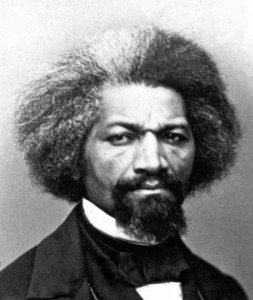“No man can put a chain about the ankle of his fellow man without at last finding the other end fastened about his own neck.”- Frederick Douglass
The late Frederick Douglass was a prominent American abolitionist, author, and orator. Born into Slavery in Talbot County, Maryland, he escaped at age 20 and quickly became one of the world’s most renowned figures regarding anti-slavery activism.
Born Frederick Augustus Washington Bailey, the son of a slave mother and an unknown white man (speculated to be his mother’s master). Douglass is one of the South’s most famous examples of the region’s mixed racial heritage controversy of the time period.
Douglass spent his early years under his grandparents’ supervision where he was exposed to the brutalities of slavery firsthand.
At age eight, Douglass was sent to live in Baltimore, at the home of Hugh Auld. It was there he first began to read and write. Picking up the words “abolition” and “justice” that would resonate in the mind of a young revolutionary.
“Going to live [in] Baltimore laid the foundation and opened the gateway to all my subsequent prosperity,” later said Douglass.
Planning to escape slavery was a mission that Douglass failed twice prior to successfully running away at age 20. On his third attempt, he was assisted by Anna Murray, a free black woman in Baltimore with whom Douglass had fallen in love and would later marry.
Upon escaping slavery, the abolitionist adopted a new surname, Douglass, of the hero of Sir Walter Scott’s The Lady of the Lake. The name change assisted in staying free of recapture from his former owner while also helping Douglass to break mental ties to a life he left behind.
He traveled by train, stopping in New York, before settling down in New Bedford, Massachusetts with his wife where he continued to improve his literacy through reading and writing. He joined many organizations and often went to abolition meetings.
It was at one of these meetings in 1841 that he saw William Lloyd Garrison speak at the Bristol Anti-Slavery Society’s annual meeting where Douglass was inspired by the speaker.
“No face and form ever impressed me with such sentiments [the hatred of slavery] as did those of William Lloyd Garrison,” said Douglass. He impressed Garrison too, in deciding to mention him in the Liberator, Garrison’s weekly journal.
After attending Garrison’s speech Douglass delivered his own at the Anti-Slavery Society’s annual convention in Nantucket, Massachusetts. His eloquence and ability to move the crowd resulted in a request to become a lecturer for the Society for three years. This would be the launch of a career that would continue throughout Douglass’ long life.
Douglass immortalized his formative years as a slave in the first of three autobiographies, Narrative of the Life of Frederick Douglass, An American Slave, published in 1845. My Bondage and My Freedom (1855) and The Life and Times of Frederick Douglass (1881).
These three novels would go down as some of the greatest contributions by a Black man to Southern culture, African-American history, and American history.
After the publishing of his autobiography Douglass went on a two-year speaking tour to avoid recapture of a previous owner. During his time abroad he became world acclaimed and established a name for himself and his fight against slavery.
Douglass welcomed the Civil War in 1861 as a moral crusade to eradicate the evil of slavery. Post Civil War, he was appointed to several political positions including his presidential role of the Freedman’s Savings Bank and as chargé d’affaires for the Dominican Republic.
Douglass became the first African American nominated for vice president of the United States as Victoria Woodhull’s running mate on the Equal Rights Party ticket in 1872. His nomination marked the first time that an African American appeared on a presidential ballot.
Brilliant and heroic, Douglass became a symbol of his age and a unique voice for humanism and social justice after passing in 1895. Happy Black History Month!
Sources: history,com / docsouth.unc.edu / pbs.org / biography.com








